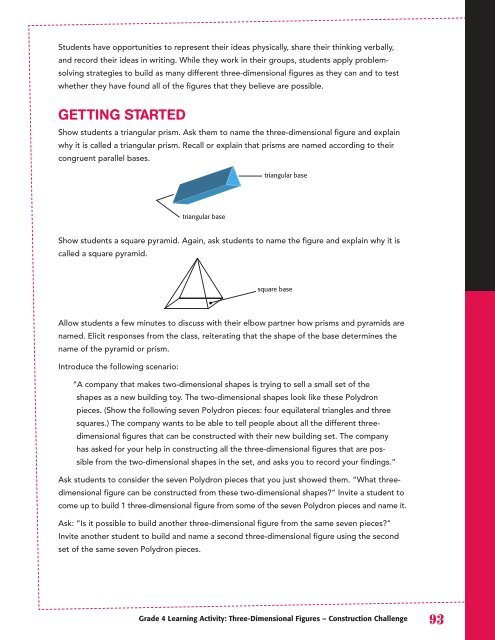Geometry and Spatial Sense, Grades 4 to 6 - EduGains
Geometry and Spatial Sense, Grades 4 to 6 - EduGains
Geometry and Spatial Sense, Grades 4 to 6 - EduGains
Create successful ePaper yourself
Turn your PDF publications into a flip-book with our unique Google optimized e-Paper software.
Students have opportunities <strong>to</strong> represent their ideas physically, share their thinking verbally,<br />
<strong>and</strong> record their ideas in writing. While they work in their groups, students apply problem-<br />
solving strategies <strong>to</strong> build as many different three-dimensional figures as they can <strong>and</strong> <strong>to</strong> test<br />
whether they have found all of the figures that they believe are possible.<br />
GETTING STARTED<br />
Show students a triangular prism. Ask them <strong>to</strong> name the three-dimensional figure <strong>and</strong> explain<br />
why it is called a triangular prism. Recall or explain that prisms are named according <strong>to</strong> their<br />
congruent parallel bases.<br />
Show students a square pyramid. Again, ask students <strong>to</strong> name the figure <strong>and</strong> explain why it is<br />
called a square pyramid.<br />
Allow students a few minutes <strong>to</strong> discuss with their elbow partner how prisms <strong>and</strong> pyramids are<br />
named. Elicit responses from the class, reiterating that the shape of the base determines the<br />
name of the pyramid or prism.<br />
Introduce the following scenario:<br />
“A company that makes two-dimensional shapes is trying <strong>to</strong> sell a small set of the<br />
shapes as a new building <strong>to</strong>y. The two-dimensional shapes look like these Polydron<br />
pieces. (Show the following seven Polydron pieces: four equilateral triangles <strong>and</strong> three<br />
squares.) The company wants <strong>to</strong> be able <strong>to</strong> tell people about all the different three-<br />
dimensional figures that can be constructed with their new building set. The company<br />
has asked for your help in constructing all the three-dimensional figures that are pos-<br />
sible from the two-dimensional shapes in the set, <strong>and</strong> asks you <strong>to</strong> record your findings.”<br />
Ask students <strong>to</strong> consider the seven Polydron pieces that you just showed them. “What three-<br />
dimensional figure can be constructed from these two-dimensional shapes?” Invite a student <strong>to</strong><br />
come up <strong>to</strong> build 1 three-dimensional figure from some of the seven Polydron pieces <strong>and</strong> name it.<br />
Ask: “Is it possible <strong>to</strong> build another three-dimensional figure from the same seven pieces?”<br />
Invite another student <strong>to</strong> build <strong>and</strong> name a second three-dimensional figure using the second<br />
set of the same seven Polydron pieces.<br />
triangular base<br />
triangular base<br />
square base<br />
Grade 4 Learning Activity: Three-Dimensional Figures – Construction Challenge

















